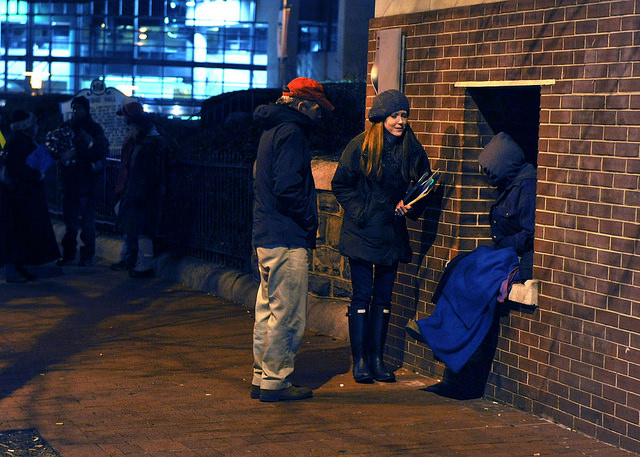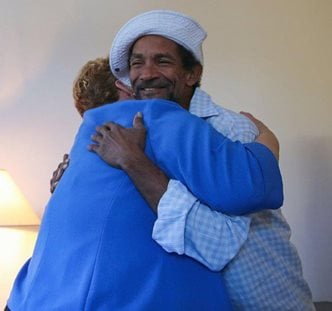
More than 20 cities and states across the country have declared an end to veteran homelessness. In voluntary compliance with federal guidelines, they have developed a system to move every identified veteran who is in need and is willing to accept help into permanent housing. And, with more than 850 state, city and county leaders on record as accepting First Lady Michelle Obama’s challenge to end veteran homelessness, more communities are expected to make similar announcements in the coming weeks and months.
How are they doing it? To see what’s working, we spoke to officials from Virginia, New Orleans and Houston, each of which recently reached this milestone. Although their situations are unique, many common approaches stand out. For instance, efforts in all three jurisdictions were jumpstarted following local officials’ attendance at a series of homeless veteran “rapid-results boot camps" held around the country in 2012 and 2013. Other common ingredients of success include goal-setting and coordination of resources, systems and people.
Top-level leadership and coordination are key
Matt Leslie beamed with pride when Gov. Terry McAuliffe took to the podium on Veterans Day 2015 and proclaimed Virginia had housed 1,432 homeless veterans since the previous October—becoming the first state to systemically end veteran homelessness.For Leslie, it affirmed the role his office played, with visible backing from the governor, in coordinating people and resources—from the federal departments of Veterans Affairs (VA) and Housing and Urban Development (HUD), to state agencies, to the private sector.
“What we did is make sure the local continuums of care [CoCs] and the VA worked together,” Leslie says. (HUD’s CoCs are local and regional planning bodies that coordinate housing and homeless funding and services.)
One notable outcome was a formal agreement to combine service delivery to veterans in the sprawling Hampton Roads area of the state. Now veterans were able to access all of the region’s seven public housing authorities and VA services from one place, without having to travel to multiple government offices.
This cooperation led to greater state-wide awareness of the number of veterans served, how they were being served and which resources were going where. This revealed gaps in federal funding coverage, spurring the state to kick in $500,000 for rapid rehousing prevention and housing resource specialists. Dominion Virginia Power also donated $2.5 million over five years for electricity assistance for newly housed veterans. Community-level support for additional housing vouchers, move-in essentials and landlord engagement went up.

Collaboration was formalized through the Governor’s Coordinating Council on Homelessness, which mirrored the federal Interagency Council on Homelessness. In May 2014, all parties gathered at a statewide Homeless Veterans Summit to draft an action plan.
“The three key components of the commonwealth action plan,” Leslie said, “were targeting the right resources to the right veteran, specifically with HUD-VA supportive housing vouchers and services; formalizing coordination among the various parties; and using data to drive our approach. That really set the stage for all of the work in Virginia. We greatly improved service delivery and dramatically lowered barriers to care.”
Although commonwealth officials are proud to have ended veteran homelessness, “we view it as a milestone and not the end,” Leslie said, adding that the state must maintain the capacity to house an average of about 130 veterans per month. “The reality is that homeless veterans who need housing or other services come in or are or are identified regularly.”
Progress must be sustainable
In |
| Martha Kegel hugs a newly housed veteran |
“Somehow in the crush to get to zero, you have to make time to discuss how you’re going to stay at zero. As proud as we are to be the first city to reach this milestone,” she says, “we’re even prouder we’ve maintained it in the last 14 months.”
Make it systematic
Officials in Houston, which has a veteran population of roughly 330,000, reached functional zero in June. Mandy Chapman Semple, special assistant to the mayor for homeless initiatives, cites three essential ingredients to their success: identification of all permanent housing options, strong supportive services to keep newly housed veterans in housing and a coordinated method to find and serve all future veterans in need.
Starting in 2012, the city and its VA and community partners initiated the following four-part process:
- One-stop services. Everyone involved in the HUD-VASH (Veterans Affairs Supportive Housing) process comes together. At a single location, chronically homeless veterans are triaged, assessed, enrolled with the VA and connected to a housing unit—all in one day.
- Triage. Using a standardized targeting system, veterans are assessed for eligibility for HUD-VASH and SSVF (Supportive Services for Veteran Families).
- Identification. Once the initial intake is complete, the remaining veterans in need must be identified, with a goal of 100 percent.
- Stabilization. Houston prepared for “steady state” by using a single, coordinated access system across the CoC to connect homeless veterans to housing, regardless of where they were in the system.
“Only when you set a high goal and actually reach it, do you realize what’s possible,” says Laura Marsh, MD, mental health care line executive at VA’s Michael E. DeBakey VA Medical Center in Houston.
For more information:
- Visit VA’s community-by-community website to find out which other states and cities have ended veteran homelessness.
- Learn more about the VA’s homeless programs and get involved.
- Download the VA housing and employment outreach toolkits.
- If you know a veteran who is homeless or at imminent risk of becoming homeless, refer him or her to a local VA medical center, where homeless coordinators are ready to help. Veterans and their families also may call 1-877-4AID-VET to be connected to VA services.

